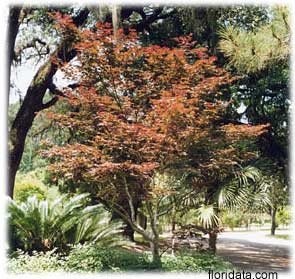New Account | Seed Mix |
Gift Certificates |AAS Winners |
Gardening Products
SEEDS: Unusual | Annuals | Perennials | Vegetables | Herbs | Trees
Japanese Maple Tree Seeds
Find your zone using Garden Web's Zone Finder

D7865
Japanese Maple ( Acer palmatum )
Photo and cultural info courtesy of Floridata.com
Japanese maple is a deciduous shrub or small tree with a broad, rounded shape. The canopy is wispy and delicate.
The species usually stays about 15-20' tall and wide, but can get larger under ideal conditions. The palmate leaves are 2-5" long and wide, and deeply dissected with 5-11 lobes. The lobes are lance-shaped, sharply pointed at the tips and doubly toothed on the edges. Japanese maple has slender, glabrous twigs and smooth gray bark. Branches tend to grow in horizontal layers, and often are contorted and twisted.
The leaves turn brilliant shades of scarlet, yellow or orange in autumn.
Location: Native to China, Korea and Japan. This lovely plant is greatly admired and is grown in temperate gardens and landscapes all over the world.
Culture: Needs a fertile, well-drained, acidic soil.
Light: Partial or filtered shade is best in warmer regions. In Florida, full shade is okay. Farther north, more sun is better. The purple-leaved cultivars require full sun or their leaves will be green.
Moisture: Not drought tolerant. Japanese maple does best with regular watering.
Hardiness: USDA Zones 5 - 8. Features: Japanese maple is the most popular garden maple. Its compact size, pretty lacy foliage, brilliant fall color and picturesque branch architecture find favor among gardeners everywhere.

